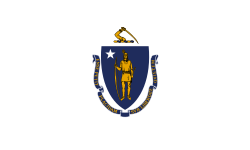- Seal of Bedford, Massachusetts
- Gostelowe Standard No. 10, a closely related American Revolution flag [6]
- Flag flown over the Goliad Declaration of Independence, 1835, utilizing a similar arm with sword design motif
- The flag of Massachusetts has a similar arm holding a sword in its design
 | |
| Use | Other |
|---|---|
| Proportion | 27:29 |
| Design | A crimson background with an armored arm holding a sword coming out of a cloud. A banner surrounds the sword that has the motto "Vince Aut Morire." |
The Bedford Flag is the oldest known flag in the United States. It is associated with the Minutemen of Bedford, Massachusetts, and the Battles of Lexington and Concord of 1775.
Contents
- Construction and design
- Origin
- Concord, April 19, 1775
- As a symbol of the Revolution
- Modern use
- Similar flags
- See also
- References
- Further reading
- External links





